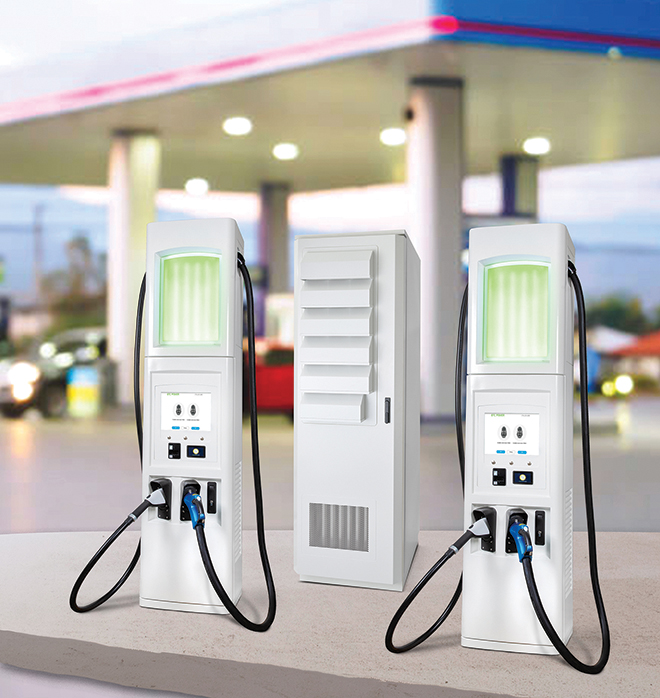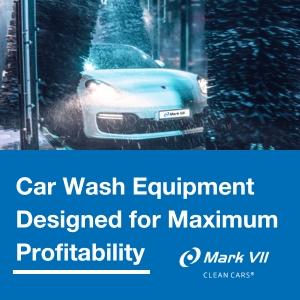
EV UPDATE

EV ARTICLE UPDATE
Electric vehicle charging remains at the forefront of transportation and infrastructure conversations among government officials, private investors and convenience and carwash owners. the Canadian government and private companies are investing heavily in the development and expansion of EV charging infrastructure across the country to meet the growing demand for electric vehicles. As of April 2023, there were 9,000 EV charging stations in Canada, according to the National Inventory of Canadian Charging & Fueling Stations. This number is expected to increase significantly in the coming years as more public and private organizations continue to invest in charging infrastructure and automobile drivers purchase electric vehicles.
Many people find their stress levels directly correlates to the battery charge level in their EV. “Range anxiety,” or the fear the amount of charge will run out before the driver can reach a charging station or destination, impacts at least a third of all EV owners. Compound this fear with frosty winter weather, and anxiety levels increase in direct proportion to the drop in temperature. This leaves one wondering, how much does cold weather affect EV battery range?
There is no reason, however, why a person in a colder climate cannot own an EV. Yet perception does not always meet reality when it comes to EVs and freezing temperatures. Time to put a few of these cold weather myths on ice.
PERCEPTION: ONLY DRIVERS IN MODERATE CLIMATES CAN CONFIDENTLY OWN AN EV
REALITY: EVS ARE POPULAR EVEN IN ARCTIC REGIONS
While cold and even hot weather extremes will decrease a vehicle’s range, it does not make it inoperable, especially when the owner takes proper precautions to extend battery life. If you do not believe that, tell that to all the EV owners in Norway.
Certainly, more notable for its colder temperatures rather than as a tropical paradise, nearly half of Norway’s land mass lies within the Arctic Circle. Yet electric vehicles accounted for 79 per cent of all new passenger car registrations in 2022, with Norway racing ahead of other countries for EV adoption.
Lest you think the EVs are mostly located in the southern portion of the Norway, according to RTL Today, in the most northern outpost in the Arctic region of Norway, where the mercury can reach minus 51°C, 54 per cent of new car registrations were electric cars.
Drivers there take advantage of coping strategies applicable in any colder region.

PERCEPTION: EV BATTERIES PERFORM POORLY IN COLD WEATHER
REALITY: WORKAROUNDS CAN MANAGE THIS PROBLEM EFFICIENTLY
Let’s further discuss one of the most common myths about EV charging in cold weather – that the batteries perform poorly in cold temperatures. This is not entirely true. While EV batteries are happiest in moderate temperatures and do not like to charge or discharge at temperature extremes, it takes a lot for them to run down completely.
For one, car manufacturers have installed battery management systems to help moderate this climatic reaction in the more recently manufactured EVs.
Secondly, a battery can be “cold saturated” because of the following:
Parking the vehicle outside for lengthy periods or overnight and the corresponding impact on battery chemistry.
The combined impact of all systems operating at once within the vehicle, causing the batteries to lose charge or lose efficiency. Efficiency is typically defined as the amount of power it takes to get from point A to point B. The combined energy it takes to power all current operating systems, such as the drive train, heater, sound systems, etc., drain the battery.
Cold temperatures can combine with other circumstances to reduce an unplugged EV’s range by up to 20 per cent but does not drain it completely.
How do you prepare for maximizing the capability of your EV battery? Plan your EV purchase. Prospective EV buyers can look for a model that includes a climate-controlled battery. Two climate control methods (forced air or glycol liquid cooling) help maintain the proper operating temperature of the battery pack.
If you already have an EV and are looking for tips for charging your EV in cold weather, don’t fear. All EVs benefit from practicing the three “Ps” of EV overnight care:
1) Park it in a garage or carport.
2) Plug it in overnight to a level 2 charger.
3) Preheat the battery.
PERCEPTION: CHARGING AN EV IN COLD WEATHER IS NOT POSSIBLE
REALITY: EV FAST CHARGING STATIONS ARE UP TO THE CHALLENGE
Another common myth is that charging an EV in chilly weather is impossible. Cold weather affects EV charging, and while it might take a bit longer, it is still possible. Additionally, EV chargers in North America and Europe are all rated to operate within a range of minus 30° C to plus 50° Celsius. Some vendors, like BTC Power, supply chargers that operate from -40°C to plus 60°C.
Many of the charging devices in today’s vehicles include heaters located strategically to ensure not just the battery but that all moving parts operate despite the cold, such as contacts closing completely. Effectively, a powered electronics device such as the charger becomes self-heating, ranging from approximately 93 per cent efficiency up to about 96 per cent efficiency.
Heaters also keep liquids within the system flowing, as liquids of many types tend to become thicker, or less viscous as the weather turns colder. The liquid within the BTC Power charger flows continuously and doesn’t freeze, similar to leaving pipes on drip during cold weather.
PERCEPTION: EV CHARGERS ARE DIFFICULT TO MANIPULATE IN COLD WEATHER
REALITY: CHARGE YOUR CAR AND KEEP THOSE MITTENS ON
While most EV charging cables are constructed of plastic and rubber, which can become stiff in colder temperatures, a proper ergonomic design for the charging cables and touchscreen can make it easier to manage in cold weather.
EV charging manufacturers, like BTC Power, balance ergonomics with safety for reliable and quick recharging of the vehicle. This not only involves the cables plugged into the vehicle but extends to the touchscreen as well.
When instructions or tasks can only be completed using a touchscreen, in extreme temperatures, technologies such as PCAP can prove harder to utilize. Many EV chargers include mechanical buttons below the touchscreen that enable the driver to keep those gloves on, power up, and move on to the next stage of the journey.
To summarize, EV chargers have no problem working in the cold. Start with the right EV for your climate and follow the recommended instructions. Soon there’ll be nothing to stop you from driving your EV in all seasons.
Here is a handy list of tips or steps you can take to mitigate the effects of wintry weather on your EV:
1) Park your EV in a garage or carport. The warmer or more ambient temperatures inside a shelter helps the battery maintain a warmer temperature and decreases cold’s impact on its range.
2) Plug the vehicle into a Level 2 charger inside the garage. This warms the battery up to a working temperature.
3) Preheat the battery. Newer models have a preheat function or scheduled departure date built into the system. The driver can schedule the time of departure for a work assignment or trip, and the car’s system will heat up the battery to the proper state of charge (SoC). This allows the driver to be prepared to leave on schedule with a battery charged to optimal percentage.
These three practices precondition your vehicle and allow it to charge more speedily. The driver who gets frustrated at the charging station has let their vehicle sit outside in the cold all night, did not plug it in and then pulled into a charging station two miles down the road, not enough to preheat the battery. Now he’s watching the minutes tick by. This is not the fault of the charging station but the battery’s state. Preconditioning gets the battery to the desired temperature as the vehicle approaches the charging station to charge at maximum efficiency, whether plus or minus 20° F outside.
Turn your customers’ range anxiety into assurance no matter what the weather holds.
Article by the techical experts at BTC POWER



































